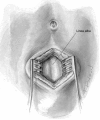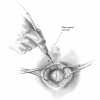Diagnostic peritoneal lavage: a review of indications, technique, and interpretation
- PMID: 19267941
- PMCID: PMC2663535
- DOI: 10.1186/1757-7241-17-13
Diagnostic peritoneal lavage: a review of indications, technique, and interpretation
Abstract
Diagnostic peritoneal lavage (DPL) is a highly accurate test for evaluating intraperitoneal hemorrhage or a ruptured hollow viscus, but is performed less frequently today due to the increased use of focused abdominal sonography for trauma (FAST) and helical computed tomography (CT). All three of these exams have advantages and disadvantages and thus each still play unique roles in the evaluation of abdominal trauma. Since DPL is performed less frequently today, a review of its indications, technique, and interpretation is pertinent.
Figures






Similar articles
-
Pelvic kidney laceration: an unusual complication of percutaneous diagnostic peritoneal lavage--case report.J Trauma. 1994 Feb;36(2):277-9. J Trauma. 1994. PMID: 8114154
-
Is diagnostic peritoneal lavage for blunt trauma obsolete?Am Surg. 1990 Feb;56(2):96-9. Am Surg. 1990. PMID: 2306058
-
Complementary roles of diagnostic peritoneal lavage and computed tomography in the evaluation of blunt abdominal trauma.J Trauma. 2001 Dec;51(6):1128-34; discussion 1134-6. doi: 10.1097/00005373-200112000-00019. J Trauma. 2001. PMID: 11740265 Clinical Trial.
-
Percutaneous diagnostic peritoneal lavage using a Veress needle versus an open technique: a prospective randomized trial.J Trauma. 1998 May;44(5):883-8. doi: 10.1097/00005373-199805000-00023. J Trauma. 1998. PMID: 9603093 Review.
-
A comparison of diagnostic peritoneal lavage and computed tomography (CT scan) in evaluation of the hemodynamically stable patient with blunt abdominal trauma.J Emerg Med. 1992 May-Jun;10(3):275-80. doi: 10.1016/0736-4679(92)90332-n. J Emerg Med. 1992. PMID: 1624738 Review.
Cited by
-
Revisiting the Use of Normal Saline for Peritoneal Washing in Ovarian Cancer.Int J Mol Sci. 2023 Nov 17;24(22):16449. doi: 10.3390/ijms242216449. Int J Mol Sci. 2023. PMID: 38003636 Free PMC article. Review.
-
Insight of Intestinal Fatty Acid Binding Protein as a Potential Biomarker in the Biology of Epithelial Damage of Gastrointestinal Membrane.Curr Protein Pept Sci. 2025;26(5):321-333. doi: 10.2174/0113892037311290240930054913. Curr Protein Pept Sci. 2025. PMID: 39754776 Review.
-
Service as joint editor-in-chief for 11 years comes to an end: adieu, godspeed and auf wiedersehn!Scand J Trauma Resusc Emerg Med. 2015 Dec 30;23:110. doi: 10.1186/s13049-015-0192-1. Scand J Trauma Resusc Emerg Med. 2015. PMID: 26718460 Free PMC article. No abstract available.
-
Propensity matched analysis of DPA or DPL used within the first hour for severely hypotensive blunt trauma patients.Surg Open Sci. 2025 Jan 25;24:1-4. doi: 10.1016/j.sopen.2025.01.005. eCollection 2025 Mar. Surg Open Sci. 2025. PMID: 39974153 Free PMC article.
-
Intraperitoneal Rupture of the Urinary Bladder Mimics an Intra-Abdominal Hemorrhage: A Case Report.Cureus. 2022 Aug 22;14(8):e28275. doi: 10.7759/cureus.28275. eCollection 2022 Aug. Cureus. 2022. PMID: 36158448 Free PMC article.
References
-
- Root HD, Hauser GW, McKinley CR, et al. Diagnostic peritoneal lavage. Surgery. 1965;57:633. - PubMed
-
- Ceraldi CM, Waxman K. Computerized tomography as an indicator of isolated mesenteric injury. A comparison with peritoneal lavage. Am Surg. 1990;56:806–810. - PubMed
-
- Meyer DM, Thal ER, Weigelt JA. Evaluation of computed tomography and diagnostic peritoneal lavage in blunt abdominal trauma. J Trauma. 1989;29:1168–1170. - PubMed
-
- Brenner DJ, Elliston CD, Hall EJ, Berdon WE. Estimated risks of radiation-induced fatal cancer from pediatric CT. AJR Am J Roentgenol. 2001;176:289–296. - PubMed
Publication types
MeSH terms
LinkOut - more resources
Full Text Sources

